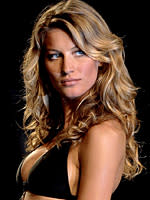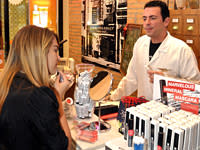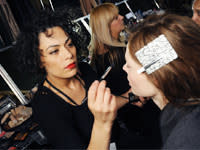For Brazil, Beauty is Serious Business
By Natalie Erlich, CNBC.com
As Brazilians get richer, so do their tastes. That's certainly true for their consumption of beauty products.

"From a cultural standpoint, women in Brazil really take their looks seriously," says Nik Modi, analyst at UBS. "Then you think about the Olympics, the income story, wage inflation and people getting more wealthy. It all bodes well."
Brazilian consumers spend an average of $240 a year on beauty products, matching the consumption of more mature markets such as the U.S. and U.K., according to Hana Ben-Shabat, a partner at A.T. Kearney, a consulting firm that advises retailers on overseas expansion.
Over the next five years, Brazil's consumption of personal care and beauty products will outpace that of developed markets including the U.S., says Ben-Shabat, who co-authored a report that ranked Brazil the most attractive market for retail expansion.
With a growth rate of 7 percent to 8 percent a year, Brazilian sales are growing four times faster than the U.S. with its 2 percent annual growth rate, she says.
"The consumer is very open to new brands and testing new products," says Ben-Shabat. "It's the ideal consumer because it's willing to invest."
The U.S. remains the largest market for cosmetics. However, Brazil, a country known for its bronzed bods and good looks, is set to overtake Japan as the world's No. 2 beauty market by next year.
"We're at an inflection point in the Brazil market," says Cedric Prouvé, group president of International for Estée Lauder. "We're seeing a graduation process where the consumers are ascending to the middle class and to higher buying power."
The growth of the country's infrastructure also is helping. The government has invested $3 billion in its airports ahead of the 2016 Olympic Games in Rio de Janiero. That will not only help streamline product distribution, but also provide more opportunity for sales of cosmetics at duty-free shops.
New shopping malls have sprouted, with 16 openings in 2010, 25 in 2011, and 30 planned for this year.
And multinationals are also willing to invest big bucks on Brazil. LVMH-owned Sephora is opening its first store in Sao Paolo in April, bringing products such as St Tropez self-tanning lotion to the Brazilian consumer for the first time.
Estée Lauder will expand its portfolios too, with plans to bring Smash Box make-up, Zegna, Tom Ford and Michael Kors fragrances to the country ahead of the Olympics. And L'Oreal, which has been in Brazil for 50 years, is considering acquisitions to strengthen its position in the face of the heightened competition.

"Despite high penetration of some products, there is still considerable potential for growth in the coming years," wrote Euromonitor International, a market researcher.
Still, there will be some cultural hurdles for companies to jump. More women in Brazil buy cosmetics via direct sales rather than going to retail stores. Brazil is Avon's single biggest market, for instance, generating more than 20 percent of the company's total profits, though performance has slipped recently.
Unilever and Procter & Gamble have also made inroads with their mass market beauty lines, say analysts. Unilever will spend $500 million to launch 80 hair care products this year. And P&G has also invested heavily in its hair care brand, Pantene. Meanwhile, L'Oreal is spending $55 million to construct a new research facility in Rio de Janeiro.
Another challenge is the high import taxes levied on luxury goods, according to Didier Tisserand, managing director of L'Oreal Brazil. Any luxury item can cost 2.5- to 3-times more in Brazil than in other countries.
"A lot of Brazilians go to New York, Paris, London or Miami to do their shopping," he says. "The question is when the government will evolve its fiscal policy on importation."
To better understand the significance of this, consider: 40 percent of Estee's M.A.C. sales at the Argentinean airport are to Brazilians and 30 percent of sales at the Chilean airport are to Brazilians, Estée's Prouvé says.

That's why the expansion of duty-free stores ahead of the Olympics is good news for prestige cosmetics brands, says UBS' Modi.
Brazil accounts for less than one percent of Estée's total profits, for instance, but sales from duty-free stores make up 25 percent of its entire business. He expects the company's sales to grow faster than mass market players in the next few years, mainly because prestige beauty product sales are coming from a lower base.
Connie Maneaty, a senior analyst at BMO Capital Markets, anticipates that within 10 to 15 years, up to 4 percent of Estee's total global sales will come from Brazil.
"We're not looking at what Brazil is worth today, but what it can be worth tomorrow," says Prouvé.
More from CNBC:
Top 10 Cosmetic Surgeries in America
Celebrity Insured Body Parts
Iconic Brands That Disappeared
Video: Saks CEO on High-End Retail
